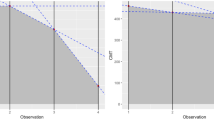Abstract
Purpose
To investigate the effects of 1% cyclopentolate hydrochloride and 1% tropicamide eye drops on aqueous flare measurements by using the laser flare meter.
Methods
One hundred forty eight eyes of 83 patients with inactive uveitis were enrolled. The patients were randomly assigned to receive either 1% tropicamide (Group 1) or 1% cyclopentolate hydrochloride (Group 2) as the mydriatic agent. Best corrected visual acuity (BCVA), intraocular pressure (IOP), aqueous flare reaction levels measured by laser flare meter device (FM 600, Kowa, Kowa Company Ltd, Nagoya, Japan) before and post dilatation agents were evaluated.
Results
Group 1 consisted of 75 eyes and Group 2 consisted of 77 eyes. The mean age of Group 1 patients was 34.85 ± 12.60 (range, 12–64) years; the mean age of Group 2 was 36.92 ± 13.30 (range, 12–70) years (p > 0.05). The mean BCVAs of two groups were 0.16 ± 0.43 (range, 0.00–3.10) logMAR and 0.17 ± 0.42 (range, 0.00–3.10) logMAR, respectively. There were no statistically significant differences between Groups 1 and 2 regarding gender or clinical characteristics (p > 0.05). No significant differences were detected in pre- or post-dilatation values between two groups (p = 0.470, p = 0.998).
Conclusions
As a result, anterior chamber flare values in uveitis patients do not differ significantly between 1% tropicamide and 1% cyclopentolate hydrochloride, and both agents can be safely used for dilatation during examination of patients with uveitis.
Similar content being viewed by others
References
Tugal-Tutkun I, Herbort CP (2010) Laser flare photometry: noninvasive, objective, and quantitative method to measure intraocular inflammation. Int Ophthalmol 30:453–464
Buyuk K, Ozkagnici A (2012) Effectiveness of topical corticosteroid on anterior chamber flare reaction after phacoemulsification surgery. Turk J Ophthalmol 42(2):120–124
Ikeji F, Pavesio C, Bunce C, White E (2010) Quantitative assessment of the effects of pupillary dilatation on aqueous flare in eyes with chronic anterior uveit is using laser flare photometry. Int Ophthalmol 30:491–494
Sawa M, Tsurimaki Y, Tsuru T, Shimizu H (1998) New quantitative method to determine protein concentration and cell number in aqueous in vivo. Jpn J Ophthalmol 32(2):132–142
Tugal-Tutkun I, Cingu K, Kir N, Yeniad B, Urgancioglu M, Gul A (2008) Use of laser flare-cell photometry to quantify intraocular inflammation in patients with Behçet uveitis. Graefes Arch Clin Exp Ophthalmol 246:1169–1177
Oshika T, Kato S (1989) Changes in aqueous flare and cell after mydriasis. Jpn J Ophthalmol 33:271–278
Oshika T, Nish M, Mochizuki M et al (1989) Quantitative assessment of aqueous flare and cells in uveitis. Jpn J Ophthalmol 33:279–287
Petternel V, Findl O, Kruger A, Schauersberger J, Amon M (2000) Effect of tropicamide on aqueous flare before and after cataract surgery. J Cataract Refract Surg 26:382–385
Shah SM, Spalton DJ, Smith SE (1991) Measurement of aqueous cell and flare in normal eyes. Br J Ophthalmol 75:348–352
El-Maghraby A, Marzouki A, Matheen TM, Souchek J, Van der Karr M (1992) Reproducibility and validity of laser flare/cell meter measurements as an objective method of assessing intraocular inflammation. Arch Ophthalmol 110:960–962
Herbort CP, Guex-Crosier Y, de Ancos E, Pittet N (1997) Use of laser flare photometry to assess and monitor inflammation in uveitis. Ophthalmology 104:64–72
Gonzales CA, Ladas JG, Davis JL, Feuer WJ, Holland GN (2001) Relationships between laser flare photometry values and complications of uveitis. Arch Ophthalmol 119:1763–1769
Schalnus RW, Ohrloff C (1998) Vergleichende Laser tyndallometrie und Fluorophotometrie bei anteriorer und posteriorer Uveitis. Ophthalmologe 95:3–7
Kıyat P, Palamar M, Guven Yılmaz S, Emre S (2019). Correlation between corneal involvement and anterior chamber flare in epidemic keratoconjunctivitis. Eur J Ophthalmol. doi: https://doi.org/10.1177/1120672119851475Online ahead of print.
Nguyen NX, Schonherr U, Kuchle M (1995) Aqueous flare and retinal capillary changes in eyes with diabetic retinopathy. Ophthalmologica 209:145–148
Nguyen NX, Kuchle M (1993) Aqueous flare and cells in eyes with retinal vein occlusion–correlation with retinal fluorescein angiographic findings. Br J Ophthalmol 77:280–283
Kuchle M, Nguyen NX, Martus P, Freissler K, Schalnus R (1998) Aqueous flare in retinitis pigmentosa. Graefes Arch Clin Exp Ophthalmol 236:426–433
Sawa M (2017) Laser flare-cell photometer: principle and significance in clinical and basic ophthalmology. Jpn J Ophthalmol 61:21–42
El-Harazi SM, Ruiz RS, Feldman RM, Chuang AZ, Villanueva G (2002) Quantitative assessment of aqueous flare: the effect of age and pupillary dilatation. Ophthalmic Surg Lasers 33:379–382
Chin PK, Cuzzani OE, Gimbel HV, Sun RE (1996) Effect of commercial dilating agents on laser flare-cell measurements. Can J Ophthalmol 31:362–365
Karaca I, Guven Yilmaz S, Palamar M, Ates H (2020) Effect of tropicamide on laser flare meter measurements in patients with pseudoexfoliation. Ocul Immunol Inflamm 17(28):947–951
Acknowledgement
This study was produced from Ege University scientific research project number 2013-TIP-106.
Funding
No financial support was received for this submission.
Author information
Authors and Affiliations
Corresponding author
Ethics declarations
Conflict of interest
The authors declare that they have no conflict of interest.
Ethical approval
All procedures performed in studies involving human participants were in accordance with the ethical standards of the institutional and/or national research committee and with the 1964 Helsinki Declaration and its later amendments or comparable ethical standards. Informed consent Informed consent was obtained from all individual participants included in the study.
Informed consent
Informed consent was obtained from all individual participants included in the study.
Additional information
Publisher's Note
Springer Nature remains neutral with regard to jurisdictional claims in published maps and institutional affiliations.
Rights and permissions
About this article
Cite this article
Yilmaz, M., Guven Yilmaz, S., Palamar, M. et al. The effects of tropicamide and cyclopentolate hydrochloride on laser flare meter measurements in uveitis patients: a comparative study. Int Ophthalmol 41, 853–857 (2021). https://doi.org/10.1007/s10792-020-01639-3
Received:
Accepted:
Published:
Issue Date:
DOI: https://doi.org/10.1007/s10792-020-01639-3




